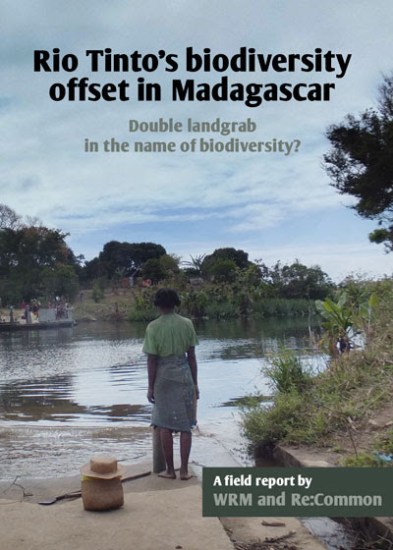 In September 2015 Re:Common and the World Rainforest Movement (WRM) carried out a joint field visit to investigate the Rio Tinto QMM biodiversity offset project in the Anosy region of south-eastern Madagascar. On the occasion of the Rio Tinto AGM on 14 April in London, WRM and Re:Common are today releasing the report that describes the findings of our investigation.
In September 2015 Re:Common and the World Rainforest Movement (WRM) carried out a joint field visit to investigate the Rio Tinto QMM biodiversity offset project in the Anosy region of south-eastern Madagascar. On the occasion of the Rio Tinto AGM on 14 April in London, WRM and Re:Common are today releasing the report that describes the findings of our investigation.
Our field investigation found that the reality around the offset site we visited is very different from the picture presented in the glossy brochures distributed internationally. In particular, subsistence livelihoods of villagers at the biodiversity offset site at Bemangidy-Ivohibe are made even more precarious by the biodiversity offset.
Villagers at this offset site felt that restrictions had been imposed without negotiation and with little regard for their situation. The biodiversity offset linked to the Rio Tinto QMM ilmenite mine in Madagascar has been widely advertised as a biodiversity offset model. The biodiversity offset has been used to justify destruction of a unique forest in the littoral zone – a forest type with extremely high species endemism and with only few unfragmented remnants left.
What we found at the Bemangidy-Ivohibe biodiversity offset site was everything but exemplary in many ways. We appeal to you to use the occasion of the Rio Tinto AGM in London and opportunities in the near future to raise the issue of the biodiversity offset reality in Madagascar with the company.
Claiming that this biodiversity offset initiative could contribute to a “Net Positive Impact” on biodiversity in the region affected by the QMM ilmenite mine is misleading, to say the least. In addition, the glossy brochures fail to address the severe negative social impacts the biodiversity offset is causing for villages such as Antsotso – a community affected by the Bemangidy-Ivohibe offset site.
Villagers of Antsotso in particular are left in a dire situation as a result of the Rio Tinto QMM biodiversity offset at Bemangidy-Ivohibe, some 50 kilometers to the north of the mining site. They lost the land used to grow their staple food, manioc, at the edge of the forest. The only place left for them to grow manioc now are the sand dunes. Manioc production in the sand dunes is not going well. As a result of the Rio Tinto biodiversity offset project at Bemangidy-Ivohibe, families with no cash income to buy food are left without sufficient food to feed their families.
The report is available in English and French. A summary in Italian is available here.
A Malagasy version is available on request.



